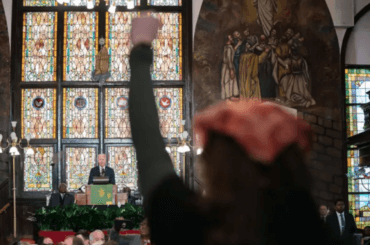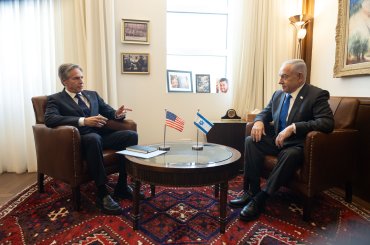Israel’s war on Gaza has brutally blurred the distinctions between civilian and military objects, motives, and identities. Over the past four weeks, civilian spaces have made up much of the theater of war. Priority targets for air strikes in Gaza have included apartment blocks, hospitals, an ambulance convoy, communications infrastructure, a university, refugee camps, fishing boats, and schools. Following attacks by Hamas on civilians and military installations in the areas surrounding Gaza, the war has incurred over 10,000 Palestinian casualties in a month.
It is a challenge to imagine that these strikes on civilian infrastructure and institutions are merely a byproduct of the war on Hamas. Indeed, destruction of infrastructure is part of the Israeli military’s intended endgame, and remarks by Prime Minister Benjamin Netanyahu have suggested his support for military actions that target noncombatants. Airstrikes on civilians are also seen as a means of reducing threats to Israeli forces, according to the former deputy commander of the IDF’s Gaza Division: “When our soldiers are maneuvering, we are doing this with massive artillery, with 50 airplanes overhead destroying anything that moves.” International requests to the state of Israel for a ceasefire have been refused.
In more temperate commentary, Israeli officials have explained that the campaign’s strategy hinges on the destruction of the built environment because it “is focused on degrading Gazan military infrastructure that is often built near homes and civilian institutions.” Perhaps more comfortably for American audiences, this implies that the destruction of civilian sites is effectively coincidental, given the dual purpose that they serve for a military adversary. Yet these actions, and the logic justifying them, are causing civilians—a disproportionate share of whom are children and infants—to be traumatized, crushed under rubble, burned, exposed to disease, and killed.
Indeed, separating Israel’s attacks on Hamas and its attacks on everyday Palestinians is a fiction that cannot be credibly maintained. Though Israel has claimed to uphold the humanitarian provisions of the Fourth Geneva Conventions, its official statements represent Hamas and civilians as functionally equivalent. Digital trackers posted by the Israeli military describe Palestinian death totals in terms of “terrorists we eliminated.” On October 13, Israeli President Isaac Herzog directly implicated all Palestinians in the October 7 attack by Hamas, claiming, “It is not true this rhetoric about civilians not being aware, not involved. It’s absolutely not true.” And in an interview on October 29, former IDF intelligence officer Eliyahu Yossian stated “There are no innocents in Gaza, there are 2.5 million terrorists” and called for “maximum corpses” and “zero morality” in the assault on Gaza.
Elsewhere, civilians have been continually depicted as culpable Hamas supporters, clandestine “terrorists,” hapless “human shields”—and thus assets to Hamas—, or inconsequential casualties in regrettable but “proportionate” strikes.
The practice of conflating everyday Palestinians with combatants—indeed, a refusal to cast civilians as civilians—has echoed through the comments of influential Americans over recent weeks as well. Reporting on the incident at Al-Ahli Arab Hospital on October 17, in which hundreds of people occupying the hospital’s courtyard were killed in a strike of unidentified origin, CNN journalist Anderson Cooper described it as a “huge civilian loss of life”—then immediately corrected himself, saying “a huge loss of life.” Nancy Pelosi and Hillary Clinton have endorsed the claims that a ceasefire would “only benefit Hamas” and “be a gift to Hamas”—a morally inflammatory framing that erases civilians or makes them appear guilty by association.
There is less daylight than mainstream Democrats would like to admit between this position and a November 1 comment on the House floor by Republican Congressman Brian Mast: “I would encourage the other side to not so lightly throw around the idea of ‘innocent Palestinian civilians,’ as is frequently said. I don’t think we would so lightly throw around the term ‘innocent Nazi civilians’ during World War II.”
In a social media video of November 3, lawyer Alan Dershowitz rhetorically inquired: “When you look at these civilian deaths, you have to ask yourself—how many of them are really civilians?” This was a shocking insinuation to put forward in the immediate wake of serial bombings on a refugee camp. Indeed, in a 2014 editorial, Dershowitz presented the case for why Israel’s current actions cannot be construed as acceptable under international law. Ironically, the hypothetical he describes runs closely parallel to the strike on Jabalia refugee camp, which apparently targeted a single Hamas commander:
For example, if a low-ranking soldier has taken refuge in a school, hospital, or mosque, and attacking him would risk hundreds of civilian lives, such an attack would be disproportional to the military value of killing the soldier — and would, therefore, constitute a war crime.
Because they cannot openly defend war crimes, Dershowitz and mainstream advocates for a wholesale war are compelled to question the “innocence” of everyday Palestinians and their civilian social institutions, such as universities and hospitals. This is a deeply dangerous moral logic. Though it can sound quieter than rhetoric branding Palestinians “human animals,” the de-civilianizing of Palestinians in Gaza is equally dehumanizing—and it creates a deeper, darker fog of war. To de-civilianize is to deprive people of their status and rights as non-combatants under international humanitarian law.
The claim that Palestinians in Gaza are not really innocent, given their possible votes for Hamas in 2006, their hypothetical future votes for Hamas, and their conjectured status as members of Hamas—underpins a militarizing worldview in which everyday people cannot exist outside a logic of deterrence, intervention, and control. In an insurgency putatively fought by irregulars, Hamas targets are imagined to be omnipresent—whether they are solar panels, bakeries, or a hospital treating cancer patients. In this calculus, no one can stake a valid claim to safety, health, or life: to be alive in Gaza is to be a “human shield.”
Indeed, at its most paranoid and inhumane, the conflation of civilians with Hamas casts some of Gaza’s most vulnerable citizens as terrorists. Children and infants are among the groups who most urgently need homes to live in, beds to sleep in, food to eat, water to drink, caregivers, and functioning communities to support their well-being. In the optic of counterinsurgency—an approach to combat that targets community support for clandestine fighters—children’s needs may indeed be seen, perversely, as aligned with the needs of combatants. Yet, in wartime, children and infants are also disparately vulnerable to injury, illness, and death. The international non-governmental organization Save the Children has reported that the child death toll in Gaza had, by October 29, exceeded the number of children killed in combat zones worldwide since 2019. In Belfast last weekend, hundreds of stuffed animals were left at the gate of the US Consulate to symbolize the Palestinian children who have been killed and to emphasize their status as innocents.
The impact of de-civilianizing rhetoric on children has not been lost on observers. Following the second IDF bombing of Jabalia refugee camp, the Israeli journalist Gideon Levy published an essay pointing to the cruelly fallacious reduction of children to “Hamas.”
A Hamas terrorist was taken out of the debris, carried in his father’s arms. His face is covered with dust, his body jerking like a sack, his stare blank. It’s not clear if he’s alive or dead. He is a toddler of three or four.
To be clear, Levy is not contending that Hamas fighters are merely innocent children; his contention is that this is a war on the most vulnerable.
After this amount of devastation, nothing will seem like a gift to Palestinians for a very long time. But the cruel math of civilian deaths to date should suggest that declaring a ceasefire would be, above all, a “gift” to the infants and children of Gaza, and restoring access to food, water, fuel, electricity, communications, and medical care would be too. En route to these critical demands, seeing and describing everyday Palestinians—adults as well as the very young—as non-combatants would be a small but meaningful step towards protecting their rights.



Lawyer Alan Dershowitz rhetorically inquired: “When you look at these civilian deaths, you have to ask yourself—how many of them are really civilians?”
How many Israelis are really civilians? They all, or almost all, serve in the military. Or they did. Or they will when they grow up.
I understand perhaps 80% of Israelis want Hamas and sympathizers eliminated.
Many have also been upset that financial assistance has been paid following acts by wingnut/lone wolf killings. Many have been upset about the tolerance of no rules, “any means necessary”, struggling. Perhaps Abbas will find benefit to respecting Biden’s request to end such payments. Probably wouldn’t make Netanyahu happy but could possibly open diplomatic opportunities.
None of this would be a surprise to anyone who lived through WWII, with the self-serving Allied justifications for their carpet bombing of German centres of population, the firebombing of Japanese cities and, obviously, the nuclear attacks on the undefended cities of Hiroshima and Nagasaki. It appears that the fascist State of Israel has learned many lessons from that period on how to conduct its war on the people of Palestine, such as the use of white phosphorus.
https://www.rferl.org/a/the-dresden-bombing-seventy-five-years-on/30432338.html